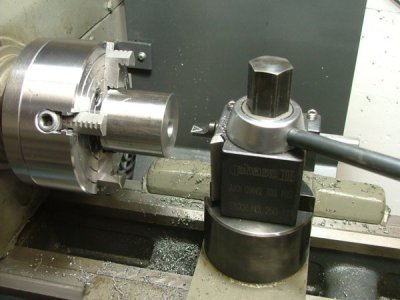- Joined
- Oct 18, 2016
- Messages
- 2,872
So, I needed a piece of 2" OD round bar to make a short spacer the other day. Since I had none in the spares box, I asked my son who works part time at a
machine shop, if he could find something in the scrap bin and band saw a short length for me. (His boss is fine with this.) He brought it home, but had no
idea what the material was. Last night I began by facing off and immediately ran into problems with chatter, and rough surface finish. My best result was
with a HSS bit in a Diamond Toolholder, very little DOC, positive feed rate at a low spindle RPM, and lots of oil. He looked into what this stuff is, and it's Acralloy
HT SRD. Specs look like this:

Acralloy® HT SRD G & P
HOT ROLLED & COLD FINISHED
PACIFIC ACRALLOY® has satisfied the high strength precision shafting requirements of the Pacific Northwest for decades. Acralloy® is drawn or turned then heat treated by quenching and tempering for high strength. It is then specially straightened, stress relieved, and ground and polished to 16 maximum rms. Acralloy® has good toughness as well as high strength and is the choice for many heavy duty shafting applications. It can be welded if properly preheated. Acralloy® can also be surface hardened by induction heat treating and by nitriding.
CHEMICAL COMPOSITION
Heat Analysis - ranges and limits %
C
.38/.45
Mn
.75/1.00
P
.035 max
S
.040 max
Cr
.80/1.10
Mo
.15/.25
TYPICAL PROPERTIES
Approximate - not for specification
Tensile (psi)
120,000
Yield (psi)
100,000
Elongation
20%
Hardness
255 HB
Machinability
55%
I've drilled it and need to bore the ID to 1.5", so before I begin I thought I'd ask for advice. My setup is a 1/2" carbide boring bar with triangular inserts. I have
both HSS and carbide inserts for this bar. Gibs all tightened up, compound replaced with a post, so as rigid a setup as I can make it. Depth will only be about
5/16" . Should I use carbide inserts and try running it fast, or HSS and run slower?, and what speeds should I aim for? The lathe is a 10" Logan.
I also need to part it off in the end. Any advice?

Next time I'll probably just buy some 12L14!
machine shop, if he could find something in the scrap bin and band saw a short length for me. (His boss is fine with this.) He brought it home, but had no
idea what the material was. Last night I began by facing off and immediately ran into problems with chatter, and rough surface finish. My best result was
with a HSS bit in a Diamond Toolholder, very little DOC, positive feed rate at a low spindle RPM, and lots of oil. He looked into what this stuff is, and it's Acralloy
HT SRD. Specs look like this:

Acralloy® HT SRD G & P
HOT ROLLED & COLD FINISHED
PACIFIC ACRALLOY® has satisfied the high strength precision shafting requirements of the Pacific Northwest for decades. Acralloy® is drawn or turned then heat treated by quenching and tempering for high strength. It is then specially straightened, stress relieved, and ground and polished to 16 maximum rms. Acralloy® has good toughness as well as high strength and is the choice for many heavy duty shafting applications. It can be welded if properly preheated. Acralloy® can also be surface hardened by induction heat treating and by nitriding.
CHEMICAL COMPOSITION
Heat Analysis - ranges and limits %
C
.38/.45
Mn
.75/1.00
P
.035 max
S
.040 max
Cr
.80/1.10
Mo
.15/.25
TYPICAL PROPERTIES
Approximate - not for specification
Tensile (psi)
120,000
Yield (psi)
100,000
Elongation
20%
Hardness
255 HB
Machinability
55%
I've drilled it and need to bore the ID to 1.5", so before I begin I thought I'd ask for advice. My setup is a 1/2" carbide boring bar with triangular inserts. I have
both HSS and carbide inserts for this bar. Gibs all tightened up, compound replaced with a post, so as rigid a setup as I can make it. Depth will only be about
5/16" . Should I use carbide inserts and try running it fast, or HSS and run slower?, and what speeds should I aim for? The lathe is a 10" Logan.
I also need to part it off in the end. Any advice?

Next time I'll probably just buy some 12L14!

